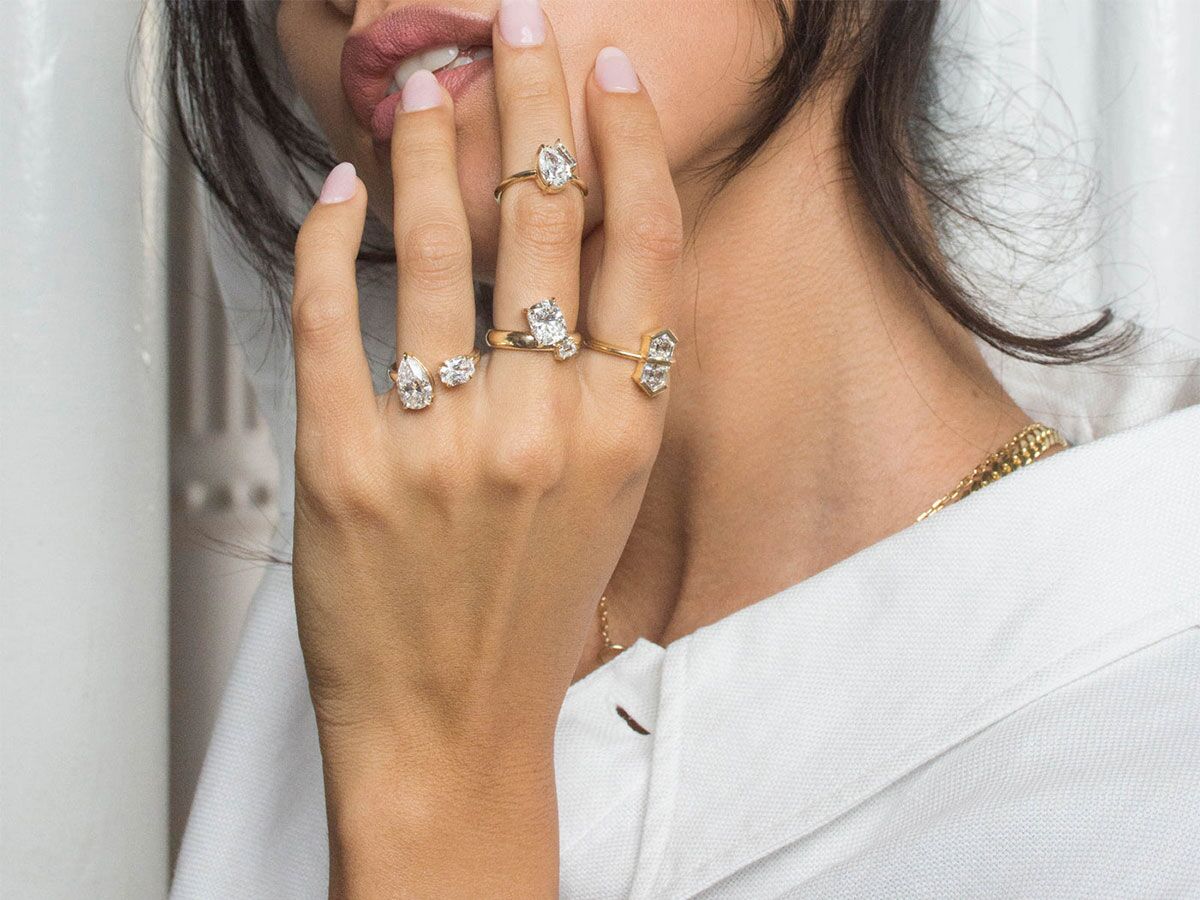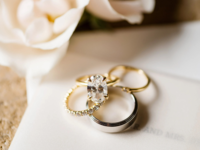Moissanite vs. Diamond Price: How It's Determined and Why It Matters

When choosing a stone for an engagement ring, couples are no longer limited to diamonds or bound by tradition. Now, they're investigating all their options, checking out moissanite, lab-grown diamonds and even colored gemstones. While moissanite vs. diamond price might be one determining factor, it shouldn't be the only factor; there's so much to consider. We tapped a couple of experts to help explain the differences between natural diamonds, lab diamonds and moissanite, and their respective costs.
Christine Razny-Porter is Chicago-based Razny Jewelers' third-generation owner, a graduate gemologist and the creator of her own everyday luxury jewelry line, Refined by Razny; she specializes in natural diamonds. Jerry Taylor is a gemologist and cofounder of Taylor Custom Rings in Carlsbad, California. His company crafts custom engagement rings that feature lab-grown diamonds and moissanite.
Since many people wonder is moissanite a real diamond—and the answer is no—let's start with a primer. "A natural diamond is a precious stone formed deep within the earth over billions of years through intense pressure and heat," Razny-Porter explains. "These gemstones are mined, cut and polished to reveal their sparkle." They are graded by cut, color, clarity and carat (the 4Cs of diamonds). Lab-grown diamonds are chemically and physically the same as natural diamonds but are mass-produced in a lab, where scientists work to recreate the natural pressure conditions that cause diamonds to form. Moissanite is made up of silicon carbide crystals and does exist in nature: It was first discovered in 1893, when a French chemist stumbled upon the crystals in a meteorite crater in Arizona. However, it's extremely rare, and therefore, most moissanite on the market is lab-produced.
There are commonalities and differences between the three, all of which we'll explore below. But if you're deciding between a diamond engagement ring vs. moissanite, remember it's not all about money. "Natural diamonds offer more than their monetary value," Razny-Porter says. "For example, owning a natural diamond offers a tangible asset that can be passed down through generations. Think of it as an heirloom with lasting emotional and symbolic significance." Taylor agrees that your choice shouldn't simply be viewed as an investment as much as it should be something that carries personal meaning, especially when it comes to engagement rings. "Jewelry should be seen as an emotional investment more than a financial one," he says. "Ultimately, the choice between diamond and moissanite comes down to personal preference and budget."
In this article:
- Moissanite vs. Diamond: What's the Difference?
- Moissanite vs. Diamond: Price Differences
- Moissanite vs. Diamond: Which is Better?
Moissanite vs. Diamond: What's the Difference?
You can look at moissanite compared to a diamond in a few different ways. Here, our experts break down some of the most common to keep in mind.
Appearance
Can you tell the difference between diamond and moissanite visually? In some ways—and in some light—yes. "Moissanite closely resembles a diamond but does have a unique difference," Taylor says. "Moissanite tends to exhibit distinct sparkle and colorful flashes, attributed to its higher refractive index. Some individuals appreciate the vibrant effects of moissanite, while others don't prefer the 'disco ball' effect that occurs, especially in direct sunlight."
Hardness
"Gemstones are evaluated using the Mohs scale, which measures hardness based on scratch resistance," Taylor explains. "Diamonds rank at the top with the highest rating of 10, while moissanite follows closely behind at 9.25." While the hardness of moissanite vs. diamond is slightly lower, Taylor says it's still an excellent option for everyday wear and is very durable.
Origin and Impact
Since almost all moissanite is produced in labs, the origin is one point where the gemstone diverges from natural diamonds and finds similarities with lab diamonds. "While there are notable distinctions between moissanite and lab-grown diamonds, one significant advantage they both offer is the potential for more ethical sourcing," Taylor says. "Lab-created diamonds and moissanite are beautiful options that have a much lighter environmental impact compared to conventional mined diamonds." (That said, the natural diamond industry is making great strides toward ethical practices; Razny-Porter elaborates below.)
Grading
"While diamonds are evaluated using the 4Cs—color, cut, clarity and carat—moissanite lacks a standardized grading system," Taylor says. "However, we can still use the 4Cs as a framework for comparison." Colorless diamonds (known on the GIA grading scale as D, E or F) are more valuable; moissanite comes in a range of color qualities, and colorless is similarly the most valuable. Higher quality moissanite also displays fewer (or virtually no) internal inclusions—similar to a VVS1 or VVS2 grade diamond.
Contrary to popular belief, carat is ranked lowest in importance when it comes to gemstone quality, Razny-Porter explains. "Remember that color, clarity and cut all influence a diamond's brilliance and perceived size," she says. "Bigger isn't always better, as two diamonds of the same carat weight can differ significantly in quality. Striking a balance between these factors is key to finding the perfect diamond." And no matter the grade of any stone, "once it is set, it's rarely viewed under magnification," Razny-Porter says. "So select it based on how it looks to the naked eye."
Moissanite vs. Diamond: Price Differences
"One of the main benefits of moissanite is its affordability compared to diamonds, making it an attractive option for those seeking a bigger look at a fraction of the price," Taylor says. As another alternative, "lab-grown diamonds are typically less expensive than natural diamonds; however, this lower cost reflects their mass production," Razny-Porter adds. She suggests considering long-term value in addition to considering price. "Natural diamonds are formed deep within the earth, making them rare and one-of-a-kind; they hold their worth because of their limited supply and timeless appeal, commanding a higher price at resale or trade-in," she says. "Over time, natural diamonds can also appreciate, especially as demand continues to grow while discoveries of high-quality stones become scarcer." The cost of all three stones varies greatly. Take a look at the average prices below and use our free wedding budget tool to see which option works best for your wallet.
Moissanite vs. Natural Diamond Price
It's hard to compare a natural diamond ring vs. moissanite as the cost discrepancy is so wide. As an example, at Brilliant Earth, a 3-carat oval diamond costs between $15,000 and $40,000 depending on quality (and that is for the stone alone, before the setting). At the same retailer, a moissanite stone of roughly the same size costs $2,850.
Moissanite vs. Lab-Grown Diamond Price
Moissanite is considerably less expensive than natural diamonds; it's also less expensive than lab diamonds, albeit less drastically. At Taylor Custom Rings, a 3-carat oval solitaire engagement ring with moissanite costs $2,575; its identical counterpart with a lab-grown diamond of the same size costs $7,460.
Moissanite vs. Diamond: Which is Better?
There's certainly no right answer to the question of whether moissanite is better than a diamond. Moissanite is not a diamond, so the comparison is null; moissanite vs. diamond cost, however, is a comparison worth taking note of if budget is top of mind.
"Lab-grown diamonds are popular among consumers right now," Taylor says. "It's easy to understand why when you take into account the fact that they are real diamonds and cost much less. They appeal to those wanting a traditional diamond experience with ethical sourcing and a lower price tag. Moissanite, on the other hand, attracts people who appreciate its unique sparkle and even lower cost, making it a very popular choice in the market right now as well."
If environmental impact is a contributing factor in your decision, you may lean toward a lab diamond or moissanite. But Razny-Porter ensures that natural diamonds can be just as sustainable, if not more (considering the greenhouse gasses emitted in production). Just be sure you do your research on origin and processes. "Natural diamond companies have made significant strides in sustainable mining, with efforts to protect the environment and reinvest in communities by funding infrastructure, education and healthcare programs," she shares. "For example, Razny Jewelers uses alluvial mining, a natural and sustainable method, to uncover our diamonds. Instead of digging deep into the earth, this process involves collecting diamonds moved by rivers and streams over thousands of years. It's more environmentally friendly because it doesn't require large machinery or deep excavation."
There are countless benefits—and really, very few cons—to all of the three options: natural diamonds, lab diamonds and moissanite. Ultimately, the choice is yours. Which will you say, "I do," to?























